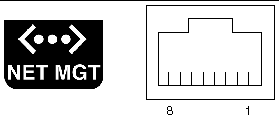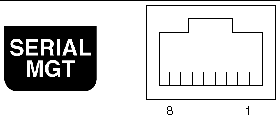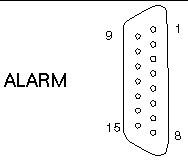| Netra 240 Server Service Manual
|
   
|
This appendix gives the pinouts for the following Netra 240 server rear ports:
Gigabit Ethernet Ports
The Netra 240 server has four autonegotiating 10/100/1000BASE-T Gigabit Ethernet system domain ports. All four Ethernet ports use a standard RJ-45 connector, the transfer rates for which are given in TABLE B-1. FIGURE B-1 shows the pin numbering of the ports, and TABLE B-2 describes the pin signals.
TABLE B-1 Ethernet Connection Transfer Rates
|
Connection Type
|
IEEE Terminology
|
Transfer Rate
|
|
Ethernet
|
10BASE-T
|
10 Mbit/s
|
|
Fast Ethernet
|
100BASE-TX
|
100 Mbits/s
|
|
Gigabit Ethernet
|
1000BASE-T
|
1000 Mbit/s
|
FIGURE B-1 Gigabit Ethernet Port Pin Numbering

TABLE B-2 Gigabit Ethernet Port Signals
|
Pin
|
Signal Description
|
Pin
|
Signal Description
|
|
1
|
Transmit/Receive Data 0 +
|
5
|
Transmit/Receive Data 2 -
|
|
2
|
Transmit/Receive Data 0 -
|
6
|
Transmit/Receive Data 1 -
|
|
3
|
Transmit/Receive Data 1 +
|
7
|
Transmit/Receive Data 3 +
|
|
4
|
Transmit/Receive Data 2 +
|
8
|
Transmit/Receive Data 3 -
|
Network Management Port
The server has one 10BASE-T Ethernet management domain interface, labeled NET MGT. For information on configuring this port for managing the server with ALOM, refer to the Sun Advanced Lights Out Manager User Guide for the Netra 240 Server (817-3174).

|
Caution - If you are planning to use the network management (NET MGT) port, you must use a shielded Ethernet cable to maintain your server's NEBS compliance. The cable's shield must be grounded at both ends.
|
FIGURE B-2 Network Management Port Pin Numbering

TABLE B-3 Network Management Connector Signals
|
Pin
|
Signal Description
|
Pin
|
Signal Description
|
|
1
|
Transmit Data +
|
5
|
Common Mode Termination
|
|
2
|
Transmit Data -
|
6
|
Receive Data -
|
|
3
|
Receive Data +
|
7
|
Common Mode Termination
|
|
4
|
Common Mode Termination
|
8
|
Common Mode Termination
|
Serial Ports
The server has two serial ports, labeled SERIAL MGT and 10101. TABLE B-4 lists the default serial connection settings for both serial ports.
TABLE B-4 Default Serial Connection Settings
|
Parameter
|
Setting
|
|
Connector
|
SERIAL MGT or 10101
|
|
Rate
|
9600 baud
|
|
Parity
|
None
|
|
Stop bits
|
1
|
|
Data bits
|
8
|
Serial Management Port
The serial management connector (labeled SERIAL MGT) is an RJ-45 connector that can be accessed from the back panel. This port is the default connection to the system, and you should use this port only for server management.

|
Caution - You must use a shielded Ethernet cable to maintain your server's NEBS compliance. The cable's shield must be grounded at both ends.
|
FIGURE B-3 shows the pin numbering of the serial management port, and TABLE B-5 describes the pin signals.
FIGURE B-3 Serial Management Port Pin Numbering

TABLE B-5 Serial Management RJ-45 Connector Signals
|
Pin
|
Signal Description
|
Pin
|
Signal Description
|
|
1
|
Request to Send
|
5
|
Ground
|
|
2
|
Data Terminal Ready
|
6
|
Receive Data
|
|
3
|
Transmit Data
|
7
|
Data Set Ready
|
|
4
|
Ground
|
8
|
Clear to Send
|
If you need to connect to the SERIAL MGT port using a cable with either a DB-9 or a DB-25 connector, use a supplied adapter to perform the crossovers given for each connector. The supplied RJ-45 to DB-9 and RJ-45 to DB-25 adapters are wired as described in TABLE B-6 and TABLE B-7.
RJ-45 to DB-9 Adapter Crossovers
TABLE B-6 RJ-45 to DB-9 Adapter Crossovers
|
Serial Port (RJ-45 Connector)
|
DB-9 Adapter
|
|
Pin
|
Signal Description
|
Pin
|
Signal Description
|
|
1
|
RTS
|
8
|
CTS
|
|
2
|
DTR
|
6
|
DSR
|
|
3
|
TXD
|
2
|
RXD
|
|
4
|
Signal Ground
|
5
|
Signal Ground
|
|
5
|
Signal Ground
|
5
|
Signal Ground
|
|
6
|
RXD
|
3
|
TXD
|
|
7
|
DSR
|
4
|
DTR
|
|
8
|
CTS
|
7
|
RTS
|
RJ-45 to DB-25 Adapter Crossovers
TABLE B-7 RJ-45 to DB-25 Adapter Crossovers
|
Serial Port (RJ-45 Connector)
|
DB-25 Adapter
|
|
Pin
|
Signal Description
|
Pin
|
Signal Description
|
|
1
|
RTS
|
5
|
CTS
|
|
2
|
DTR
|
6
|
DSR
|
|
3
|
TXD
|
3
|
RXD
|
|
4
|
Signal Ground
|
7
|
Signal Ground
|
|
5
|
Signal Ground
|
7
|
Signal Ground
|
|
6
|
RXD
|
2
|
TXD
|
|
7
|
DSR
|
20
|
DTR
|
|
8
|
CTS
|
4
|
RTS
|
Serial Port (10101)
The port labeled 10101 accepts a DB-9 connector. Use this port for general purpose serial data transfers. FIGURE B-4 shows the pin numbering of the serial port, and TABLE B-8 describes the pin signals.
FIGURE B-4 Serial Port (10101) Pin Numbering

TABLE B-8 Serial Port (10101) Connector Signals
|
Pin
|
Signal Description
|
Pin
|
Signal Description
|
|
1
|
Data Carrier Detect
|
6
|
Data Set Ready
|
|
2
|
Receive Data
|
7
|
Request to Send
|
|
3
|
Transmit Data
|
8
|
Clear to Send
|
|
4
|
Data Terminal Ready
|
9
|
Ring Indicate
|
|
5
|
Ground
|
|
|
Alarm Port
The alarm port on the alarm rear transition card uses a standard DB-15 connector. In a telecommunications environment, use this port to connect to the central office alarming system. FIGURE B-5 shows the pin numbering of the alarm port, and TABLE B-9 describes the pin signals.
FIGURE B-5 Alarm Port Pin Numbering

TABLE B-9 Alarm Connector Signals
|
Pin
|
Service
|
Pin
|
Service
|
|
1
|
INPUT0 +
|
9
|
ALARM1_NC
|
|
2
|
INPUT0 -
|
10
|
ALARM1_COM
|
|
3
|
NC
|
11
|
ALARM2_NO
|
|
4
|
NC
|
12
|
ALARM2_NC
|
|
5
|
ALARM0_NC
|
13
|
ALARM2_COM
|
|
6
|
ALARM0_NO
|
14
|
ALARM3_NO
|
|
7
|
ALARM0_COM
|
15
|
ALARM3_COM
|
|
8
|
ALARM1_NO
|
CHASSIS
|
FRAME GND
|
USB Ports
The server has two USB ports for attaching supported USB 1.1 compliant devices. FIGURE B-6 shows the pin numbering of the USB ports, and TABLE B-10 describes the pin signals.
FIGURE B-6 USB Ports Pin Numbering

TABLE B-10 USB Connector Pin Signals
|
Pin
|
Signal Description
|
|
1
|
+5 V
|
|
`2
|
DAT-
|
|
3
|
DAT+
|
|
4
|
Ground
|
SCSI Port
The SCSI port is a multimode Ultra 160SCSI interface. To operate at Ultra 160SCSI speeds, the part must be in Low Voltage Differential (LVD) mode. If a single-ended device is connected to the server, it automatically switches to single-ended mode. FIGURE B-7 shows the pin numbering of the SCSI port, and TABLE B-11 describes the pin signals.
FIGURE B-7 SCSI Port Pin Numbering

TABLE B-11 SCSI Port Pin Signals
|
Pin
|
Signal Description
|
Pin
|
Signal Description
|
|
1
|
Data12 +
|
35
|
Data12 -
|
|
2
|
Data13 +
|
36
|
Data13 -
|
|
3
|
Data14 +
|
37
|
Data14 -
|
|
4
|
Data15 +
|
38
|
Data15 -
|
|
5
|
Parity1 +
|
39
|
Parity1 -
|
|
6
|
Data0 +
|
40
|
Data0 -
|
|
7
|
Data1 +
|
41
|
Data1 -
|
|
8
|
Data2 +
|
42
|
Data2 -
|
|
9
|
Data3 +
|
43
|
Data3 -
|
|
10
|
Data4 +
|
44
|
Data4 -
|
|
11
|
Data5 +
|
45
|
Data5 -
|
|
12
|
Data6 +
|
46
|
Data6 -
|
|
13
|
Data7 +
|
47
|
Data7 -
|
|
14
|
Parity0 +
|
48
|
Parity0 -
|
|
15
|
Ground
|
49
|
Ground
|
|
16
|
DIFF_SENSE
|
50
|
Ground
|
|
17
|
TERM_PWR
|
51
|
TERM_PWR
|
|
18
|
TERM_PWR
|
52
|
TERM_PWR
|
|
19
|
(N/C)
|
53
|
(N/C)
|
|
20
|
Ground
|
54
|
Ground
|
|
21
|
ATN +
|
55
|
ATN -
|
|
22
|
Ground
|
56
|
Ground
|
|
23
|
BSY +
|
57
|
BSY -
|
|
24
|
ACK +
|
58
|
ACK -
|
|
25
|
RST +
|
59
|
RST -
|
|
26
|
MSG +
|
60
|
MSG -
|
|
27
|
SEL +
|
61
|
SEL -
|
|
28
|
CD +
|
62
|
CD -
|
|
29
|
REQ +
|
63
|
REQ -
|
|
30
|
I/O +
|
64
|
I/O -
|
|
31
|
Data8 +
|
65
|
Data8 -
|
|
32
|
Data9 +
|
66
|
Data9 -
|
|
33
|
Data10 +
|
67
|
Data10 -
|
|
34
|
Data11 +
|
68
|
Data11 -
|
| Netra 240 Server Service Manual
|
817-2699-12
|
   
|
Copyright © 2004, Sun Microsystems, Inc. All rights reserved.







